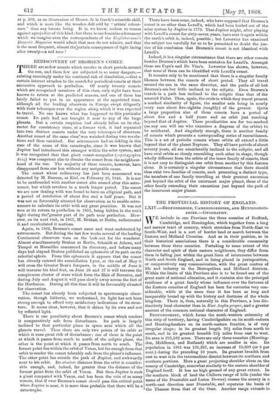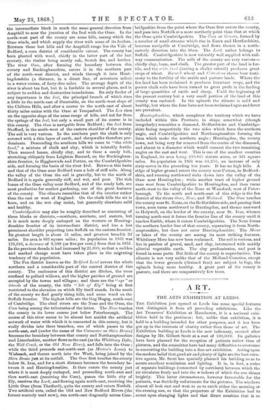W E include in one Province the three counties of Bedford,
Cambridge, and Huntingdon, which together form a long and narrow tract of country, which stretches from North-East to South-West, and is a sort of border land or march between the Eastern and Midland Counties. And as in their position, so in their historical associations there is a considerable community between these three counties. Partaking to some extent of the character and spirit of their eastern neighbours, they differ from them in falling just within the great lines of intercourse between North and South England, and in being placed in juxtaposition, or comparatively easy communication, with the great centres of life and industry in the Metropolitan and Midland districts.. Within the limits of this Province also is to be found one of the great seats of national education, and it contains also the principal residence of a great family whose influence over the fortunes of the Eastern counties of England has been for centuries very con- siderable, while at the same time it has been as long and inseparably bound up with the history and destinies of the whole kingdom. There is, then, naturally in this Province, a less dis- tinctively local character than in East Anglia proper, and a greater amount of the common national character of England.
BEDFORDSHIRE, which forms the south-western extremity of this strip of territory, having Cambridgeshire on its south-eastern and Huntingdonshire on its north-eastern frontier, is of very irregular shape ; in its greatest length 361 miles from north to south, and in its greatest breadth 221 miles from east to west. Its area is 295,582 acres. There are only three counties (Hunting- don, Middlesex, and Ratland) which are smaller in size. Its population in 1861 was 135,287, an increase of 10,809 (or 9 per cent.) during the preceding 10 years. Its greatest breadth from east to west is in the intermediate district between its northern and southern portions. Here a great projecting shoulder abuts on the county of Cambridge, somewhat similarly to the eastern shoulder of England itself. It has no high ground of any great extent. In the southern block of land the Chiltern range of hills (under the name of the Dunstable and Luton Downs) crosses the county in a. north-east direction near Dunstable, and separates the basin of the Thames from that of the Ouse. Another range extends in the intermediate block in much the same general direction from Ampthill to near the junction of the lye! with the Ouse. In the north-west part of the county are some hills, among which the Ouse winds, and which supply the river with some of its feeders. Between these last hills and the Ampthill range lies the Vale of Bedford, a corn district of considerable extent. The county has been planted with wood, chiefly in the latter part of the last century, the timber being mostly oak, Scotch firs, and larches. The river Ouse, after forming the boundary between this county and Buckinghamshire, enters it in the southern part of the north-west district, and winds through it into Hunt- ingdonshire (a distance, in a direct line, of seventeen miles) in a water course, of forty-five miles. The average depth of the river is about ten feet, but it is fordable in several places, and is subject to sudden and destructive inundations. Its only feeder of any importance is the Ivel, the principal branch of which rises a little to the north-east of Dunstable, on the north-west slope of the Chiltern Hills, and after a course to the north-east of about thirty miles unites with the Ouse at Tempesford. The Lea rises on the opposite slope of the same range of hills, and not far from the springs of the lvel, but only a small part of its course is in this county. The Ouse is navigable from Bedford ; the lvel from Shefford, in the south-west of the eastern shoulder of the county. The soil is very various. In the southern part the chalk is only covered with a thin layer of earth, and sheepwalks therefore pre- dominate. Descending the southern hills we come to "the white land," a mixture of chalk and clay, which is tolerably fertile. Then succeed learns, chiefly clay, and to these a sandy belt, stretching obliquely from Leighton Buzzard, on the Buckingham. shire frontier, to Biggleswade and Potton, on the Cambridgeshire side, and forming the basin of the river Ivel. Between this basin and that of the Ouse near Bedford runs a belt of stiff soils. Along the valley of the Ouse the soil is gravelly, but to the north of Bedford it is again generally stiff, and wet, and poor. The rich 'cams of the Ouse valley near Bedford, and of the sandy belt, are moat productive for market gardening, one of the great features of the county. The climate resembles that of the interior rather than the east or west of England. On the chalk hills the air is keen, and on the wet clay moist, but generally elsewhere mild and healthy.
Cambridgeshire may also be roughly described as consisting of three blocks or districts,—northern, southern, and eastern, but it is much more deeply embayed on the western or Hunting- donshire frontier of its intermediate district, and has a less prominent shoulder projecting into Suffolk on the eastern frontier. Its greatest length is about 51 miles, and greatest breadth 32 miles. Its area is 893 square miles ; its population in 1861 was 176,016, a decrease of 9,389 (or five per cent.) from that in 1851. In the previous decade it had increased by 21,000, so that a sudden and marked change must have taken place in the migrating tendency of the population.
The Fen district known as the Bedford Level covers the whole northern and a considerable part of the central district of this county. The enclosures of this district are ditches, the trees confined to pollard willows, and the higher patches of ground are occupied by the towns and villages ; and these are the "eys " or islands of the county, the title "Isle of Ely" being at first restricted to the elevation on which Ely itself stands. In the south of the county we find gently rising hills, and some wood on the Suffolk frontier. The highest hills are the Gog Magog, south-east of Cambridge. The chief rivers are the Nene and the Ouse, the Cam being among the tributaries of the latter. The Nene touches the county in its lower course just below Peterborough. The course of this river seems to be almost lost amidst the artificial network of water with which it is connected in this county, but it really divides into three branches, one of which passes to the north-east, and (under the name of the Catswater or Shire Drain) becomes the boundary between that county and Northamptonshire and Lincolnshire, another flows to the east (as the Whittlesey Dyke, the Well Creek, or the Old Nene River), and falls into the Ouse ; while the third proceeds east-north-east (as Morton's Learn) to Wisbeach, and thence north into the Wash, being joined by the Shire Drain just at its outfall. The Ouse first touches the county below St. Ives, and for a short distance becomes the boundary be- tween it and Huntingdonshire. It then enters the county just where it is most deeply embayed, and proceeding south-east and then north-east (receiving the Cam), passes the little city of Ely, receives the Lark, and flowing again north-east, receiving the Little Ouse (from Thetford), quits the county and enters Norfolk. Two artificial cuts, called the Old and New Bedford Rivers (the former scarcely used now), run north-east diagonally across Cam-
bridgeshire from the point where the Ouse first enters the county, and pass into Norfolk at a more northerly point than that at which the Ouse quits Cambridgeshire. The Cam or Crania, formed by a number of small streams which rise in Essex and Hertfordshire, becomes navigable at Cambridge, and flows thence in a north- easterly direction into the Ouse. The Lark rather belongs to Suffolk. Cambridgeshire is now tolerably well supplied with rail- way communication. The soils of the county are very various— chiefly clay, loam, and chalk. The greater part of the land is fer- tile, and the white land (having a chalky subsoil) produces great crops of wheat. Burwell wheat and Cottenham cheese bear testi- mony to the fertility of the arable and pasture lands. Where the fen land has been reclaimed it produces luxuriant crops, and the poorer chalk soils have been turned to great profit in the feeding of large quantities of cattle and sheep. Until the beginning of the present century but a very small portion of the land of this county was enclosed. In the uplands the climate is mild and healthy, but where the fens have not been reclaimed ague and fever are prevalent.
Huntingdonshire, which completes the territory which we have included within this Province, in shape somewhat (though irregularly) resembles a diamond, Bedfordshire and Cambridge- shire facing respectively the two sides which form the southern angle, and Cambridgeshire and Northamptonshire forming the lines which make the northern angle ; Huntingdon, the county town, not being very far removed from the centre of the diamond, and almost in a diameter which would connect the two remaining angles on the east and west. This is one of the smallest counties in England, its area being 230,865 statute acres, or 361 square miles. Its population in 1861 was 64,250, an increase of only sixty-seven in the preceding ten years. It has no high hills. A ridge of higher ground enters the county near Potton, in Bedford- shire, and running northward sinks down into the valley of the Ouse near Huntingdon ; while another tract of higher ground runs west from Cambridgeshire to Huntingdon, and then turns north-west to the valley of the Nene at Wansford, west of Peter- borough. To the north and north-east of this ridge is the fen district of the rivers Ouse, Nene, and Welland. The Ouse touches the county near St. Neots, on the Bedfordshire side, and passing that town, soon turns northward to Huntingdon, and thence eastward to Holywell, on the border of the county, near St. Ives, whence turning north-east it forms the frontier line of the county until it reaches Earith, where it enters Cambridgeshire. The Nene forms the northern border line of that county, separating it from North- amptonshire, but does not enter Huntingdonshire. The Meres or lakes of the county are among its most striking features. Whittlesey Mere has now been reclaimed. The soil is various, and lies in patches of gravel, sand, and clay, intermixed with muddy alluvial vegetable earth. The clay predominates, and peat is found in some parts. But little of the county is unproductive. The climate is not very unlike that of the Midland Counties, except that the lower grounds (drained fens) are subject to fogs, the uplands being more healthy. A great part of the county is pasture, and there are comparatively few trees.



































 Previous page
Previous page